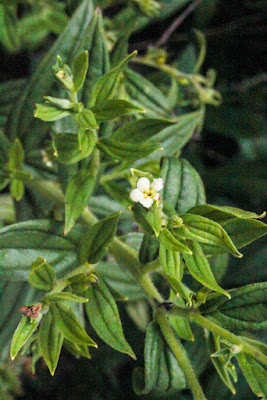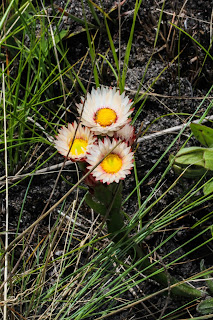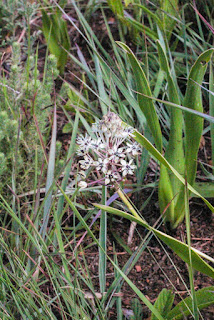We had not visited the Ngele mountain area for some months, and as November has proved in the past to be good for Asclepiads we set off early and met up with the recently appointed DAFF Forestry Officer, Mr Sebenzile Joyi. After giving him a copy of the recently published species list for the area, we set off to the Belfast Lookout area with Security Guard and guide, Mr Robertson Madwe, and after the arduous and relatively precarious climb up to the plateau where the grasslands are, we got out of the vehicle to see what was flowering on this occasion.
Surprisingly, despite the poor rains, the grassland was full of colour with Indigofera hillaris and Eriosema distinctum providing the background tones of red and orange, interspersed with white, pink, and yellow of less common species.
 |
| Eriosema distinctum |
 |
| Indigofera hillaris |
Hiding shyly amongst the grass were many Resnova lachenalioides and in this area we have found this species to be an indicator of a yet-to-be-described species, Xysmalobium rhodanthum (ined.) - this proved to be true again as there were several of the Xysmalobium rhodanthum in flower. Sprawling across the rocks were numbers of bright yellow Xysmalobium tysonianum with attendant pollinators.
 |
| Resnova lachenalioides |
 |
| Xysmalobium rhodanthum (ined.) |
 |
| Xysmalobium tysonianum |
There were many of the short stalked Watsonia confusa, but, unlike previous years, we could find none of the mimic species Disa pulchra. Senecio barbatus flowers provided a colour and texture contrast, and dotted around were numbers of the delicate orchid, Disa stricta.
Moving on to another section of this grassland, we came across some shrubby Lessertia perenans in flower, some Cerastium arabidis, and in a wetland area near a small stream we found Nidorella undulata, Wahlenbergia rivularis, a Disa cornuta and Satyrium bracteatum. On the slopes above the stream were several Helichrysum vernum.
 |
| Lessertia perenans |
 |
| Cerastium arabidis |
 |
| Wahlenbergia rivularis |
 |
| Disa cornuta |
 |
| Satyrium bracteatum |
 |
| Helichrysum vernum |
On a steep slope a little further on we found a Disa oreophila in flower, and following the stream downslope we came across some daisy family shrubs that we will need some help with. Also alongside the stream we saw a Lithospermum afromontanum. While having lunch in the shade of some trees, we found a Maytenus acuminata in flower, and two Streptocarpus pusilus hiding under a rock.
 |
| Disa oreophila |
 |
| Lithospermum afromontanum |
 |
| Maytenus acuminata |
 |
| Streptocarpus pusilus |
After tackling the track down the mountain again, we stopped off at a grassland near the Ntunta River to look at a tree Robertson had found the previous day. We collected more material here and this subsequently turned out to be Commiphora woodii, a species not previously recorded at Ngele; well spotted Robertson. Another species to be added to the list. In this same grassland we saw Pachycarpus concolor and Orthochilus leontoglossus.
 |
| Orthochilus leontoglossus |
 |
| Pachycarpus concolor |
 |
| Collecting a specimen of Commiphora woodii |
We then headed homeward after a long but satisfying day.
Participants: Anne S, Graham G, Kate G, Robertson M, Uschi T.













































































